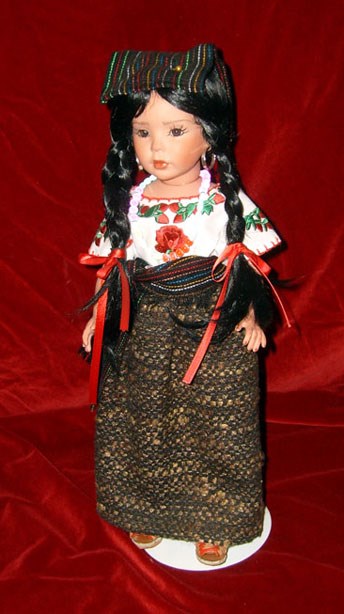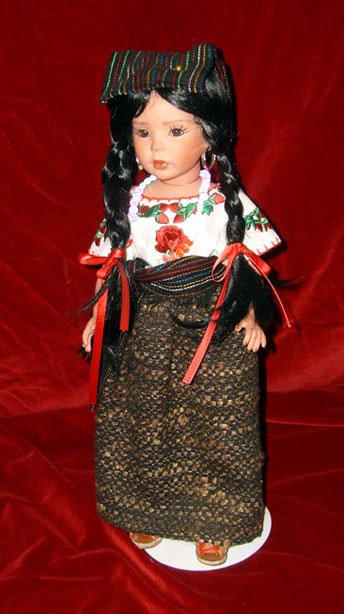
Capital: Toluca The white blouse richly embroidered with red roses, the woven sash and belled skirt of rustic cloth, and a traditional petob (head covering) fastened to the hair reflect the typical dress of the Nahua. Numbering well over a million, the Nahuas are the largest group of indigenous people in the country, living mainly in Morelos, Puebla, Tlaxcala, and Mexico. Seven different tribes of Nahuatlacas speak Nahuatl, also known as Mexicano. They carried the powerful influence of the Aztec culture through the Spanish conquest into modern day Mexico where they've integrated with the general population while maintaining a connection to their native soil. The Mazahuas, living predominately in the State of Mexico, number fewer than 150 thousand. A derivation of the Otomies, the Mazahuas have endured through the centuries, inhabiting parts of the country since pre-Hispanic times. Generally, they devote themselves to cultivating their small parcels of land, but will frequently migrate to the cities in search of work. The Otomi are concentrated principally in Hidalgo, Puebla, Tlaxcala, Veracruz, and Mexico. Many live in poverty, cultivating the poor soil to produce maguey (also called agave). They build their homes from its large spiny leaves and use it to produce pulque, an alcoholic drink. Many Africans who came to Mexico entered what are now the southern states, then migrated northward, leaving traces of African influence in everything from music (the popular marimba originated in Africa) to mulattos (people of mixed race). Mexico's War of Independence was fought by Indians, mestizos, and mulattos, among whom were both Jose Maria Morelos y Pavon, a leader of the independence movement, and Vicente Guerrero, Mexico's second president. The State of Mexico is the site of a unique annual phenomenon: the 5,000 kilometer migration of millions of colorful, fragile creatures, each weighing less than on gram. Each November, monarch butterflies leave Canada for the Monarch Butterfly Sanctuary, a wooded area spanning the border of Mexico and Michoacan, to spend the winter maturing and reproducing. In February and March, they return to Canada. The pyramid of Teotihuacan, "the place of the gods," rises from the floor of the Valley of Mexico, an archeological zone in the northeast of the state. Ancient indigenous people believed it is the birthplace of the gods, including Quinto Sol, without whom nothing could exist. The state's economy is largely industrial, based in the production of automobiles, paper, textiles, and chemicals, as well as machine assembly and food industries. Textiles include woolen and cotton items, carpentry, wooden carvings, pottery, metal and basketwork. The Zumpango region is known for its paper lampshades, onyx and obsidian figures, and stone molcajetes or mortars. Did You Know…? 
Capital: Toluca de Lerdo La vestimenta típica del Nahua se compone de una blusa lujosamente bordada con rosas rojas, una faja tejida, una falda circular de manta y el tradicional petob (tocado) sujetado al cabello. Con una población de más de un millón de habitantes, los Nahuas son el grupo indígena más numeroso, viven principalmente en Morelos, Puebla, Tlaxcala, y México. Siete tribus diferentes de nahuatlacas hablan Náhuatl. Este grupo indígena ha conservado la influencia de la cultura azteca a pesar de la conquista española y ha permanecido hasta nuestros días donde se han integrado a la población manteniendo una conexión con sus raíces. Los Mazahuas, viven principalmente en el estado de México, su población no llega a los 150,000 habitantes. Subgrupo de los Otomíes, los Mazahuas han permanecido durante siglos, habitando el país desde tiempos prehispánicos. Generalmente, se dedican al cultivo de pequeñas parcelas, pero con frecuencia emigran a las ciudades en busca del trabajo. Los Otomíes viven principalmente en Hidalgo, Puebla, Tlaxcala, Veracruz, y México. Muchos viven en la pobreza, cultivan el maguey (también llamado agave), construyen sus casas con las grandes hojas espinosas y también lo usan para producir pulque, una bebida alcohólica. El estado de México es anfitrión de unos de los fenómenos anuales más espectaculares de la naturaleza: la migración de millones de pequeñas y coloridas criaturas, pesando menos de un gramo cada una. Cada noviembre, recorriendo una distancia de 5,000 kilómetros, la mariposa Monarca sale de Canadá y se dirige al Santuario de la Mariposa Monarca, área boscosa que se encuentra entre la frontera de México y Michoacán, a pasar el invierno, época durante la cual estas criaturas frágiles maduran y reproducen antes de partir hacia el norte en la primavera. La pirámide de Teotihuacán, "lugar de dioses", se eleva sobre el suelo del Valle de México, zona arqueológica en el noreste del estado. Los antiguos indígenas tenían la creencia de que esa zona era el lugar donde nacían los dioses, incluyendo el Quinto el Sol, sin el cual nada podría existir. La economía del estado se basa principalmente en la industria automovilística, papel, textiles, y sustancias químicas, así como el ensamble de maquinaria y la industria de alimentos, carpintería, madera labrada, cerámica, metal, y artículos de mimbre. El textil incluye artículos de lana y de algodón. La región de Zumpango se conoce por sus pantallas de papel, ónix, y figuras de obsidiana y por sus molcajetes de piedra o morteros. Sabías que…? |
Last updated: February 24, 2015
